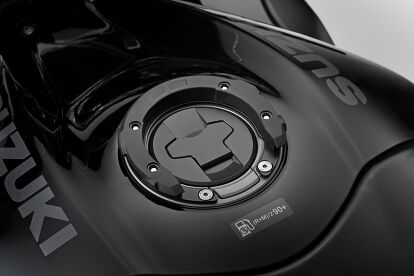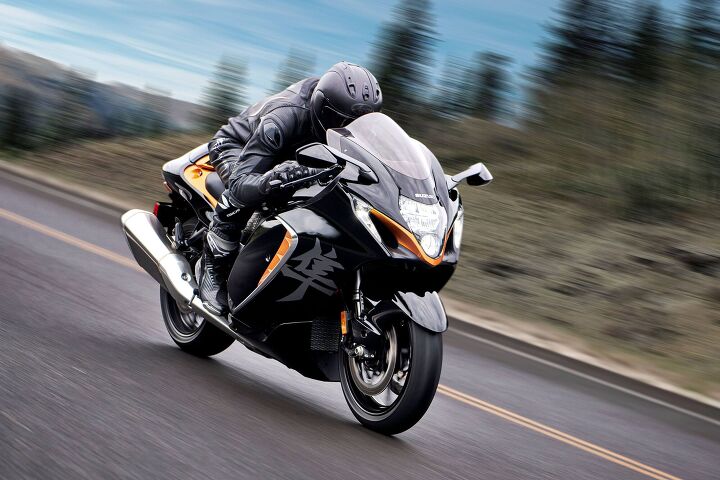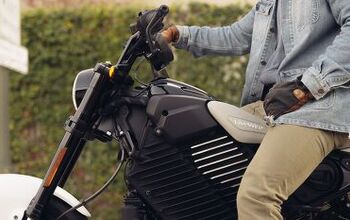2022 Suzuki Hayabusa First Look

Everything you wanted to know about Suzuki's flagship except what it's like to ride
For a segment of motorcycling as technologically-driven as sportbikes, 14 years is an eternity – even more so for a category that Suzuki calls the Ultimate Sportbike – but that’s how long it’s been for the Hayabusa. While there was an incremental update in 2013 that brought ABS to the table, until today, the Hayabusa, a motorcycle that, on its inception way back in 1999 had claimed the title of “world’s fastest production motorcycle,” had only undergone two generational updates: the original release and the 2008 revamp. However, today’s announcement of the 2022 Suzuki Hayabusa adds another chapter to this earth-bound missile.
When considering the Hayabusa, two features immediately come to mind. First, is the iconic look of the slippery fairing inspired, according to Suzuki, by the peregrine falcon, which the manufacturer has long boasted of having “one of the lowest drag coefficients achieved on a production bike.” The nose of the fairing swoops back over the windshield, carrying the arc of the bike’s lines over the back of the tucked-in rider before curving down over the tail section’s prominent hump – a look that has only been enhanced in the 2022 version. The second prominent feature of the Hayabusa is almost completely hidden from view but is almost as iconic as the motorcycle’s profile (Just ask drag racers). A 1340cc inline-Four is responsible for the thrust that propels the Hayabusa to a speed-limited 185 mph.
Naturally, when considering a new generation of an existing motorcycle, inquiring minds want to know if it is a whole-cloth, ground-up update. In the case of the 2021 Hayabusa, the answer would be no. However, the changes are by no means minor. While the essential structure of the engine and the chassis remain the same, they have both been “refined” and “thoroughly updated,” respectively (according to Suzuki’s press materials), with the sum of the new or revised parts reaching a lofty 550 in total. Anyone who has seen the Hayabusa’s 1340cc engine naked would recognize it immediately because the changes are on the inside. The same could likely be said of the chassis, from the swoopy bodywork to the twin-spar aluminum frame to the identical 58.3-inch wheelbase. So, why don’t we start with the engine?
The Engine Compartment
Before diving into the engine’s specifics, we need to consider the engineer’s goals when making the 2022 updates. Since Suzuki intends to continue honoring the gentleman’s agreement of a 299 kph (185 mph) top speed that ended the top speed wars among the Japanese manufacturers, more horsepower wasn’t really needed. In fact, we’ll say the quiet part out loud: the new ‘Busa’s peak crank horsepower of 187.75 hp is 6.65 hp less than the previous generation’s output. Now, before you start heading down the rabbit hole of conspiracy theories, consider this: If the top speed is a given, where can the pocket calculator set strut their stuff? How about by beefing up the low- and mid-range performance plus increasing efficiency, and why not toss in Euro 5 compliance, too?
So, the Hayabusa’s displacement remains the same, as does its 81.0 mm x 65.0 mm bore and stroke. However, a host of internal changes were directed towards the portions of the rpm range where street bikes spend the bulk of their time. The pistons have a new shape and are lighter to the tune of 26 grams each. The connecting rods lose 3 grams each and feature a new design for increased rigidity. Even the piston pins got in on the fun and are a shorter length for an unspecified weight loss.
Above the pistons, The combustion chamber was revised, reducing the flow coefficient by 5% for a more efficient burn of the air/fuel charge. To assist in the goal of improving low- and mid-range power, the valve overlap was reduced. Additionally, the exhaust lift was increased.
Throughout the engine, other improvements, ranging from updated lubrication to larger needle bearings, improve durability and efficiency. Even the cooling system gets in on the upgrade party with an 8% increase in airflow when moving and 7% when the fan is running at a standstill.
Intake and Exhaust
To help the engine produce the desired power gains, Suzuki turned to an updated throttle system powered by ride-by-wire. Each of the 43mm throttle bores has two injectors. The primary injector sprays directly down the bore, while a new Suzuki Side Feed Injector sprays its fuel against a reflecting plate ahead of the butterfly valve. This results in a 2% increase in horsepower and torque in the low- and mid-range. The entire intake tract has increased in length by 12mm, again to increase power in the desired rpm range. The airbox also received a capacity bump from 10.3 liters to 11.5 liters.
The exhaust is all new and sheds 4.5 lb compared to the previous generation. The four-into-two-into-one-into-two exhaust features a new crossover pipe from cylinder #1 to #4 similar to the existing one from #2 to #3, assisting in the desired power gains. To help the Hayabusa meet emission standards, the exhaust has three high-flow catalysts, one in the central collector and one in each muffler. The mufflers themselves are a combined 1.98 liters smaller, assisting in the weight loss, and they feature an exterior body that will change color over time, depending on how the motorcycle is ridden.
The Chassis
The Hayabusa’s chassis was designed to be lighter, move the center of gravity lower to the ground, and achieve 50/50 front/rear weight distribution. As with the previous generations, a twin-spar aluminum frame and swingarm are utilized and tuned for the right amount of stiffness for its job description. That’s not to say that it’s only set up for high-speed, straight-line runs. The Hayabusa was always the better handling bike of this class, so spirited cornering is in its bag of tricks.
The frame is aided by an updated suspension. The 43mm inverted KYB fork’s full adjustability was updated with new internals, and the shock, also fully adjustable, received upgrades to assist in straight-line stability. The seven-spoke aluminum wheels are new – as are the bespoke Bridgestone S22 tires.
The brakes are upgraded with Brembo’s popular Stylema four-piston radial-mount calipers squeezing 320mm discs. Out back, a single 260mm disc is embraced by a single-piston caliper. The ABS has undergone a massive change that we’ll cover when outlining the electronics package.
Slippery Bodywork
Since Suzuki has posted the Hayabusa’s top speed as being 185 mph, aerodynamic bodywork is a must. Consequently, trips to the wind tunnel were in order, and the new skin, while looking sharper, provides what Suzuki describes as a modest “improvement on lift and stability at high speed.” This attention to detail goes as far as slotting the brake and clutch levers to minimize the forces they are subjected to at maximum velocity. The windscreen design serves a dual purpose by directing the airflow to suit both a tucked and upright riding position while giving full visibility to the instruments.
The ram air intake is a great example of Suzuki’s attention to detail. Functionally, the intake path increases the flow of the pressurized air into the airbox as road speed rockets towards 185 mph. Additionally, the center-mounted, stacked headlight and the position light/turn signal combinations on either side of the ducts do their best to assist in the airflow over the fairing.
The swoopy styling carries rearward, too. The mufflers are smaller and more tucked away for less wind resistance, and the hump mimics the shape of the rider’s curved back for smoother passage through the air. In addition to the LED lighting on the front of the Hayabusa, the brake light and the turn signals combine into a compact and visually-pleasing unit.
Electronics
With this upgrade, the Hayabusa moves into the world of 21st century electronics. This update to the Suzuki Intelligent Ride System (SIRS) brings a ride-by-wire throttle and a Bosch IMU onto the playing field, and the results should improve both rideability and safety. The Suzuki Drive Mode Selector Alpha is a long-winded way of saying ride modes. The Hayabusa comes with three factory-preset modes and three user-customizable modes. Within those modes the rider can adjust the Power Mode Selector: Mode 1 provides immediate throttle response and maximum power, Mode 2 delivers a softer, more linear power curve up to maximum power, and Mode 3 makes the power delivery tamer coupled with a reduced peak power (think Rain Mode).
Next comes the Motion Track Traction Control System or TC to those of us not employed by the company. The lean-sensitive TC offers 10 settings plus off for riders to choose from. Anti-Lift Control is just what the name describes and allows the rider to tune how much the ‘Busa intervenes in wheelies over a range of 10 settings plus off. Then there is the Launch Control System, giving the rider three choices of launch rpm/acceleration characteristics: 4,000 rpm with softer acceleration, 6,000 rpm and stronger acceleration, and 8,000 rpm and maximum acceleration from a stop.
Acceleration isn’t the only engine mode that the SIRS controls, though. The Engine Brake Control System allows the ECU to vary engine braking to limit rear-wheel skip or feel the full power of deceleration. The Bi-directional Quick Shift System is simply up/down clutchless shifting. Burns will be happy to know that the new ‘Busa comes with cruise control standard. One unique feature that stands out in the SIRS manifest is the Active Speed Limiter, which allows the rider to charge up to the set speed but not past it. Perhaps this will save some Hayabusa owners their driver’s license, but if you’re going to buy this motorcycle, why would you ever engage this bit of tech?
What goes fast, must slow down, and the big Suzuki gives riders two big braking assists. First, the Combined Brake System links the front brake lever with the rear brake to help the chassis maintain a level attitude. For those who like to use the rear brake alone to attenuate power delivery, you can do so with the knowledge that you’re not affecting the front brake at all. The second big update is the Motion Track Anti-Lock Brake System, or lean-sensitive ABS to the rest of us. You know what this does and understand that it is a good thing. What you may not have experienced before is the Slope Dependent Control System that works to minimize rear-wheel lift when braking on a downhill slope. Finally, the Hill Hold Control System does exactly what its name implies when starting on a hill.
What More Do You Want to Know?
Yeah, we want to know what the 2022 Suzuki Hayabusa is like to ride, too. Unfortunately, no date has been set for the introduction (we blame COVID-19), but we’ll keep you updated. The Hayabusa will be available in the following colors: Glass Sparkle Black and Candy Burnt Gold, Metallic Matte Sword Silver and Candy Daring Red, and Pearl Brilliant White and Metallic Matte Stellar Blue. The MSRP starts at $18,599. We have no word on when the ‘Busa will be available.
2022 Suzuki Hayabusa Specifications | |
|---|---|
| MSRP | $18,599 |
| Engine Type | 1340cc liquid-cooled inline-Four cylinder, DOHC, four valves per cylinder |
| Bore and Stroke | 81mm x 65mm |
| Compression Ratio | 12.5:1 |
| Claimed Horsepower | 187.75 hp @ 9,700 rpm |
| Torque | 110.64 lb-ft @ 7,000 rpm |
| Transmission | 6-speed constant mesh |
| Final Drive | Chain |
| Front Suspension | 43mm inverted KYB fork with spring preload, rebound and compression damping adjustability |
| Rear Suspension | Single shock with spring preload, rebound and compression damping adjustability |
| Front Brake | Dual radial-mounted four-piston calipers with 320mm discs |
| Rear Brake | Single-caliper 260mm disc |
| Front Tire | 120/70ZR17 |
| Rear Tire | 190/50ZR17 |
| Rake/Trail | 23.0 deg/3.54 in |
| Wheelbase | 58.3 in. |
| Seat Height | 31.5 in. |
| Curb Weight (Claimed) | 582 lbs. |
| Fuel Capacity | 5.3 gal. |
Become a Motorcycle.com insider. Get the latest motorcycle news first by subscribing to our newsletter here.

Like most of the best happenings in his life, Evans stumbled into his motojournalism career. While on his way to a planned life in academia, he applied for a job at a motorcycle magazine, thinking he’d get the opportunity to write some freelance articles. Instead, he was offered a full-time job in which he discovered he could actually get paid to ride other people’s motorcycles – and he’s never looked back. Over the 25 years he’s been in the motorcycle industry, Evans has written two books, 101 Sportbike Performance Projects and How to Modify Your Metric Cruiser, and has ridden just about every production motorcycle manufactured. Evans has a deep love of motorcycles and believes they are a force for good in the world.
More by Evans Brasfield



































































































































































































































































































Comments
Join the conversation
I'll take the orange and black one. And an attorney on retainer for the "Reckless Evading" charges that will no doubt ensue.
Doesn't the Suzuki Ninja H2 go over 299kph?
https://www.youtube.com/wat...